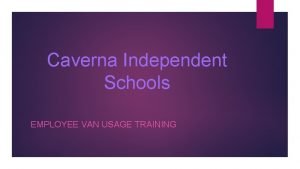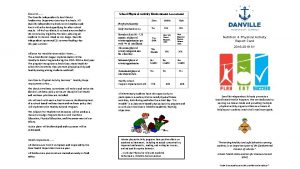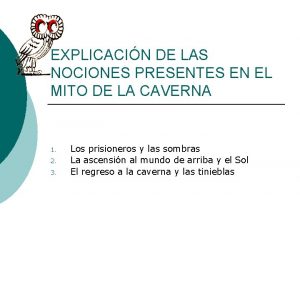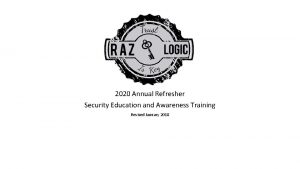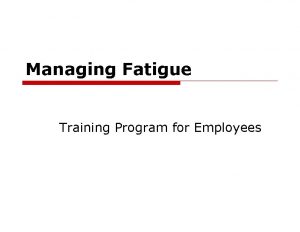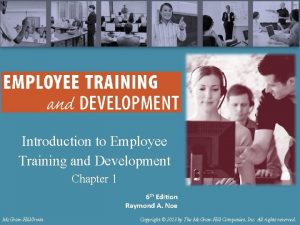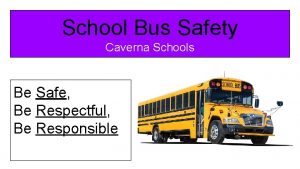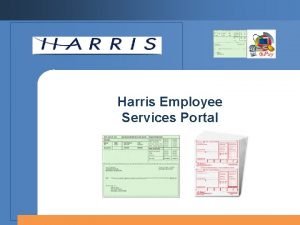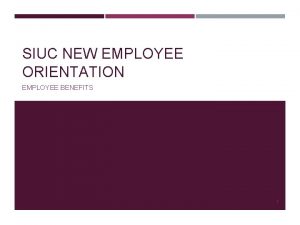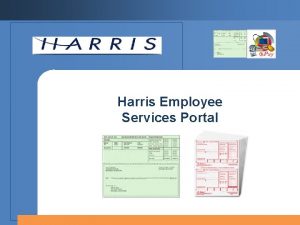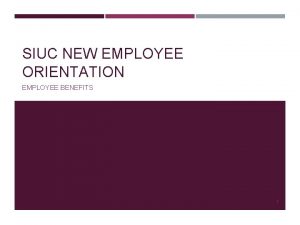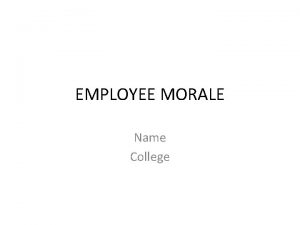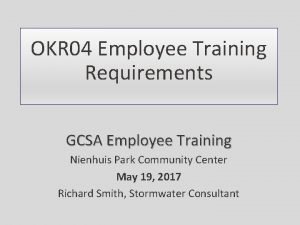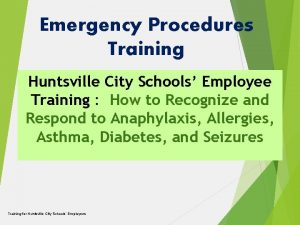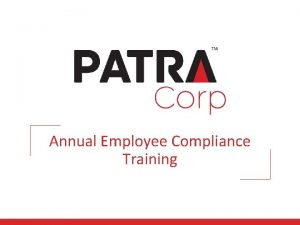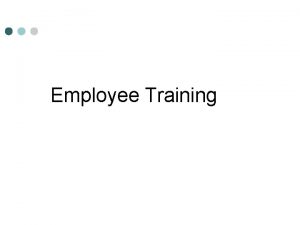Caverna Independent Schools EMPLOYEE VAN USAGE TRAINING Annual


























- Slides: 26

Caverna Independent Schools EMPLOYEE VAN USAGE TRAINING

Annual requirements Review of Power point presentation Annual MVR (Motor vehicle records) check All drivers must review power point and sign off that they have had training Go to your circuit court (driver’s licensing) and request a copy of your 3 year motor vehicle record. The cost is around $4. Current copy of driver’s license

Why is this training necessary? May 17, 2007 at 4: 05 pm this school bus (van) slams into the rear of a stopped school bus dropping off at a student stop. The van driver and the 14 year female student are killed in the crash…

Safe operation of a School Van Ensure you are well rested before driving Always practice defensive driving skills Follow all state and federal laws governing vehicle operations Do not speed Maintain a safe following distance based on traffic and road conditions When passing adhere to pavement markings, signage and applicable laws Yield right of way to pedestrians as required by law Never use an unsafe vehicle and all safety equipment is present (pre-trip violations, etc. ) Know how to operate all equipment on the vehicle and consult the vehicles owners manual for specifics for the vehicle. Students cannot be in the vehicle while it is being fueled All students must be in the vehicle before backing up 4

Violation Disclosure Requirements Employee notification requirements to be given to your employer of; DWI Disqualifying offenses (reckless driving) Moving violations The employee is required to disclose in writing within ten (10) days of conviction any of the above violations to the employer. 5

Personal Cellular Phone Call Prohibited 03. 1321 AP. 1 Employees shall not engage in activities that distract them from safely operating a vehicle Except for communications made to and from a central dispatch, school transportation department, or its equivalent, drivers shall not use a telecommunication device, including those used for calling, texting or emailing while operating a board-owned vehicle unless the vehicle is parked or unless there is a bona fide emergency, which shall include, but not be limited to the following actions: 1. Report illegal activity 2. summon medical help 3. summon law enforcement or public safety agent 4. prevent injury to a person or property

7 Emergency Preparedness Plan your route before you leave Plan evacuations for your school van Make sure the students know all the exits and how to use them Make sure all students are dressed for the weather conditions Make sure that all safety equipment is available and ready for use. Keep a list of contact names and phone numbers in case of a mechanical problem

School bus (van) emergency equipment must be properly secured in the vehicle to prevent movement. In this picture the equipment is mounted to the floor. It may also be secured in a bag or container. 8

Proper use of seat belts and child safety restraints 9 Seat Belt Requirements State law requires seatbelt usage of all passengers in the vehicle. Air bag technology has improved over the years, however air bags can still present a significant danger to students in the front seat. It is recommended students avoid riding in the front passenger seat of a school Van until they are twelve years of age and/or adult size. Always consult the vehicle owners manual for important safety information for the vehicle being operated.

Pre-trip vehicle inspection A daily pre trip inspection of the vehicle must be completed by the driver or the designated person. A copy of the pre trip must be kept with the vehicle for the current date. While completing your pre-trip inspection ensure all items are checked using your pre-trip inspection report form. Contact your supervisor if you don’t find pre-trip forms in the school bus or are having difficulty completing it.

Conduct an external inspection Walk around inspection All lights Tires (visually inspect for proper inflation also) Mirrors Windows Windshield wipers Gas cap Vehicle damage

Conduct interior inspection Check gauges and or lights Turn signal indicators ABS light Headlamp indicator (high beam) Horn Windshield wiper operation including the washer fluid Low tire pressure monitoring system is so equipped (TPMS) Dashboard and interior lights Fuel Adjust all mirrors to give you a clear view Adjust the driver seat position for your comfort and vehicle control Ensure ALL seat belts are available for use and functional Emergency equipment

What if I find something wrong during the pre-trip inspection? Good Question If you discover a mechanical problem during the pre-trip inspection contact the transportation director to ensure repairs are made prior to operating the school van. 13

Safe loading & unloading The driver of a school van shall place the transmission in park while loading or unloading of students is occurring. Safe loading and unloading of students, including, but not limited to: 1. The curb, on the non traffic side of the road 2. Off street area’s 3. Driveways 4. Yards 5. Parking lots 6. Refraining from loading and unloading students in the vehicular traffic lane, the shoulder, a designated turn lane or a lane adjacent to a designated turn lane.

Defensive driving basics Stay alert to changes Look well ahead Observe the entire situation Recognize potential hazards Decide on an appropriate plan Carry out your plan

Basics…continued � Slow Down on Rain-slicked Streets � Hydroplaning is a frightening experience and can cause serious and fatal crashes � Maintain a Safe Following Distance- minimum 4 seconds � Look out for road construction and detours as most road construction take place during the summer � Slow Down Even in Good Weather � Watch out for children playing in the streets, people will be out cycling, skating or walking

Basics…continued REDUCE YOUR DRIVING SPEED IN ADVERSE ROAD AND/OR WEATHER CONDITIONS ENTER CURVES SLOWLY REDUCE YOUR SPEED BEFORE ENTERING AN EXIT/ENTRANCE RAMP SLOW DOWN IN WORK ZONES

WARNING!!! The school van sits up higher than the vehicle you are use to driving. Always slow down on curves to avoid turning over High winds will make driving the van more difficult to control

Seeing and being seen Keep the windshield and mirrors clean and clear Use mirrors Constantly scan traffic to the front and sides Use mirrors before changing speed or position in traffic Signal all turns and lane changes

Seeing and being seen Keep lights on for safety Avoid distractions

intersections It takes longer to cross due to additional length and slower acceleration Go slow and watch for vehicles, pedestrians, people, bikes, etc. At busy unmarked intersections stop, assume you don’t have the right of way

intersections When approaching a controlled intersection stop two times First, at the stop sign or light Second, after easing forward to a point where you can clearly see oncoming traffic

merging Size up the traffic conditions Signal early Watch for an opening Build up speed Watch the mirrors Watch for oncoming traffic

Post trip inspection All lights off Emergency brake applied Check interior for cleanliness External walk around for damage Vehicle is refueled Keys returned to proper personnel Ensure all paperwork is properly completed

Rules for using the van All required paperwork must be turned in to transportation director two weeks prior to using the van. This includes MVR, driver’s license, proof that you have been trained (ppt) The driver must do a pre-trip inspection with the transportation director. Please schedule in advance. Upon return, van will be inspected by transportation director. Van should be brought back in the same condition you received it NO FOOD OR DRINKS ALLOWED IN VAN…. . EVER No nicotine products used in any school owned vehicle

Acknowledgement Form I have viewed the Employee Van Usage training power point. ________________________________ Name _______ Date
 Caverna independent schools
Caverna independent schools Employee attitudes and employee performance
Employee attitudes and employee performance Collierville schools employee portal
Collierville schools employee portal Huntsville city schools returning student registration
Huntsville city schools returning student registration Reach target safety
Reach target safety California association of independent schools
California association of independent schools Danville independent schools
Danville independent schools Antituberkulotikumok
Antituberkulotikumok Alegoria de la caverna significado
Alegoria de la caverna significado Reflexion mito de la caverna
Reflexion mito de la caverna Niveles de conocimiento del mito de la caverna
Niveles de conocimiento del mito de la caverna Leziuni micronodulare cerebrale
Leziuni micronodulare cerebrale Caverna tb
Caverna tb Gerarchia idee platone
Gerarchia idee platone Le origini della filosofia mappa concettuale
Le origini della filosofia mappa concettuale Mappa concettuale democrito
Mappa concettuale democrito Nicerato
Nicerato O mito da caverna
O mito da caverna Mito da caverna
Mito da caverna Jardim de academus
Jardim de academus Caverna pulmonara
Caverna pulmonara Cylindrical pendant organ
Cylindrical pendant organ Mapa mental mito de la caverna
Mapa mental mito de la caverna Security annual refresher training
Security annual refresher training Two main clauses
Two main clauses Employee fatigue training
Employee fatigue training Introduction to employee training and development
Introduction to employee training and development
